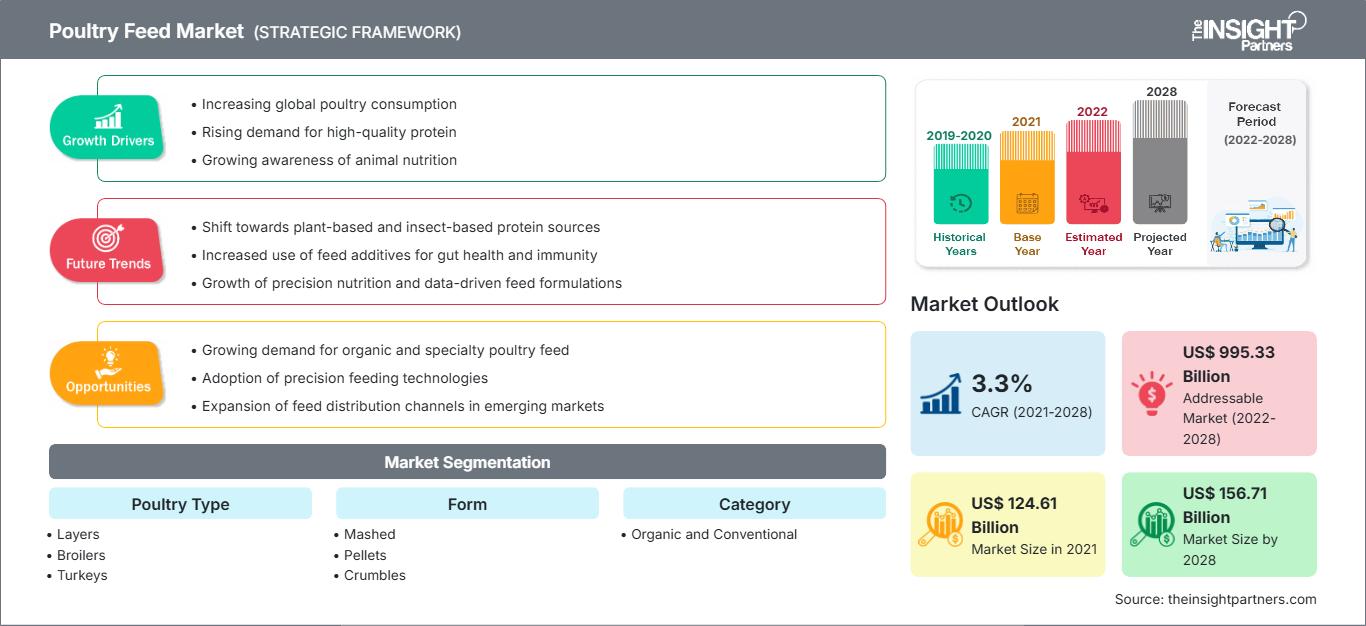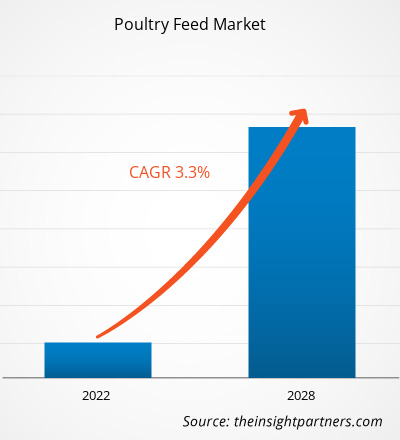Le marché des aliments pour volaille était évalué à 124 611 millions de dollars américains en 2021 et devrait atteindre 156 710 millions de dollars américains d'ici 2028 ; il devrait croître à un TCAC de 3,3 % entre 2021 et 2028.
Les aliments pour volaille sont produits à partir de diverses matières premières, telles que des céréales, des tourteaux ou des tourteaux d'huile, et des additifs alimentaires. Les besoins nutritionnels des aliments pour volaille dépendent du poids et de l'âge des volailles, de leur taux de croissance et de leur taux de ponte. L'augmentation de la consommation de produits à base de volaille stimule le marché des aliments pour volaille. En 2020, l'Asie-Pacifique détenait la plus grande part de revenus du marché mondial des aliments pour volaille. Avec une large base de consommateurs de viande de volaille, le marché des aliments pour volaille de la région Asie-Pacifique enregistre une croissance remarquable et devrait se poursuivre dans les années à venir. La Chine et l'Inde sont les deux principaux producteurs mondiaux d'aliments pour volaille. En Inde, le secteur de la production d'aliments pour volailles est l'un de ceux qui connaissent la croissance la plus rapide, la concurrence s'intensifiant entre les fabricants. Les consommateurs de cette région recherchent de nouvelles sources d'aliments riches en protéines. L'augmentation de la demande pour ces aliments, conjuguée à un pouvoir d'achat accru, a fortement stimulé la consommation de viande de volaille. Tous ces facteurs devraient stimuler la croissance du marché des aliments pour volailles en Asie-Pacifique au cours de la période de prévision.
Vous bénéficierez d’une personnalisation sur n’importe quel rapport - gratuitement - y compris des parties de ce rapport, ou une analyse au niveau du pays, un pack de données Excel, ainsi que de profiter d’offres exceptionnelles et de réductions pour les start-ups et les universités
Marché des aliments pour volaille: Perspectives stratégiques

- Obtenez les principales tendances clés du marché de ce rapport.Cet échantillon GRATUIT comprendra une analyse de données, allant des tendances du marché aux estimations et prévisions.
La pandémie de COVID-19 en cours a contraint à la mise en œuvre de mesures préventives qui ont radicalement modifié la situation de l'industrie de l'alimentation animale et ont eu un impact négatif sur la croissance du marché des aliments pour volailles. Les gouvernements du monde entier ont ordonné la fermeture de leurs ports internationaux, provoquant de nouvelles perturbations dans la chaîne d'approvisionnement en aliments pour volailles. La pandémie de COVID-19 a eu un impact sur la disponibilité des matières premières pour la préparation des aliments pour volailles dans presque tous les pays. Le maïs et le soja sont les principaux ingrédients des aliments pour volailles. De nombreux pays qui dépendent des importations de ces matières premières pour la préparation des aliments pour volailles ont rencontré d'importantes difficultés d'approvisionnement. La disponibilité des aliments pour volailles dans la plupart des régions a été difficile en raison de la fermeture des usines d'aliments pour volailles. La consommation mondiale de viande de volaille a chuté de manière drastique. L'industrie de l'alimentation pour volailles a été durement touchée par la fermeture des restaurants dans le monde entier. Cependant, alors que les économies prévoient de relancer leurs activités, la demande d'aliments pour volailles devrait augmenter à l'échelle mondiale. La demande croissante d'aliments pour volaille et les investissements importants des principaux fabricants devraient stimuler la croissance de ce secteur.
Aperçu du marché
La production avicole croissante
alimente la croissance du marché des aliments pour volaille
Le secteur avicole connaît une croissance continue dans le monde entier. La volaille est considérée comme l'une des sources de protéines les plus rentables, ce qui explique la demande croissante de produits avicoles, tels que les œufs et la viande. La consommation de poulet est en plein essor chez les personnes soucieuses de leur santé. L'essor de la production avicole répond largement aux besoins croissants de la population mondiale. Selon l'Organisation des Nations Unies pour l'alimentation et l'agriculture (FAO) des États-Unis, la production mondiale de viande de volaille est passée de 9 à 132 millions de tonnes entre 1961 et 2019, et la production d'œufs de 15 à 90 millions de tonnes. L'essor de la production avicole favorise l'utilisation d'aliments pour volailles de qualité.
Informations sur les types de volailles
Le marché mondial des aliments pour volailles est segmenté selon le type de volaille : pondeuses, poulets de chair, dindes, etc. En 2020, le segment des poulets de chair détenait la plus grande part de marché. Les poulets de chair sont des poulets élevés pour leur viande et nourris avec une alimentation riche en protéines pour favoriser une croissance rapide. Les aliments pour poulets de chair se présentent sous différentes formes, telles que la purée, les granulés et les miettes. L'Inde est l'un des plus grands producteurs de poulets de chair, avec une demande croissante d'aliments composés dans l'industrie du poulet de chair. L'augmentation de la production de poulets de chair continuera de stimuler la demande d'aliments pour volailles de chair au cours de la période de prévision.
Informations sur les formes
Le marché mondial des aliments pour volailles est segmenté selon la forme : purée, granulés, miettes, etc. Le segment des granulés détenait la plus grande part de marché en 2020. Les granulés sont fabriqués en utilisant de la vapeur et de la pression pour comprimer la farine. La farine est ensuite comprimée et moulée en granulés durs et secs dans une presse à granulés. Les granulés améliorent la croissance des poulets de chair et augmentent leur consommation. Cela est dû à une meilleure digestibilité, une ségrégation réduite des ingrédients et une appétence accrue. Grâce à un mélange homogène des ingrédients dans chaque granulé, les granulés assurent une alimentation équilibrée, une meilleure conversion alimentaire et de meilleures performances chez les volailles. Les avantages des granulés, tels qu'une alimentation facilement digestible, une alimentation équilibrée et une réduction des déchets, contribuent généralement à leur forte demande.
Quelques acteurs clés du marché mondial de l'alimentation pour volailles sont : ADM ; Cargill, Incorporated ; Alltech ; Charoen Pokphand Foods PCL ; For Farmers ; Kent Corporation ; SHV Holdings ; Land O'Lakes, Inc. ; AFGRI Animal Feeds ; et DE HEUS ANIMAL NUTRITION. Les acteurs opérant sur le marché sont fortement concentrés sur le développement d'offres de produits de haute qualité et innovantes pour répondre aux exigences des clients.
Marché des aliments pour volaille
Les tendances régionales et les facteurs influençant le marché des aliments pour volailles tout au long de la période de prévision ont été analysés en détail par les analystes de The Insight Partners. Cette section aborde également les segments et la géographie du marché des aliments pour volailles en Amérique du Nord, en Europe, en Asie-Pacifique, au Moyen-Orient et en Afrique, ainsi qu'en Amérique du Sud et en Amérique centrale.
Portée du rapport sur le marché des aliments pour volaille| Attribut de rapport | Détails |
|---|---|
| Taille du marché en 2021 | US$ 124.61 Billion |
| Taille du marché par 2028 | US$ 156.71 Billion |
| TCAC mondial (2021 - 2028) | 3.3% |
| Données historiques | 2019-2020 |
| Période de prévision | 2022-2028 |
| Segments couverts |
By Type de volaille
|
| Régions et pays couverts | Amérique du Nord
|
| Leaders du marché et profils d'entreprises clés |
|
Densité des acteurs du marché des aliments pour volaille : comprendre son impact sur la dynamique commerciale
Le marché des aliments pour volailles connaît une croissance rapide, portée par une demande croissante des utilisateurs finaux, due à des facteurs tels que l'évolution des préférences des consommateurs, les avancées technologiques et une meilleure connaissance des avantages du produit. Face à cette demande croissante, les entreprises élargissent leur offre, innovent pour répondre aux besoins des consommateurs et capitalisent sur les nouvelles tendances, ce qui alimente la croissance du marché.
- Obtenez le Marché des aliments pour volaille Aperçu des principaux acteurs clés
Points forts du rapport
- Tendances progressives de l'industrie sur le marché des aliments pour volaille pour aider les acteurs à développer des stratégies efficaces à long terme
- Stratégies de croissance des entreprises adoptées par les marchés développés et en développement
- Analyse quantitative du marché des aliments pour volaille de 2019 à 2028
- Estimation de la demande mondiale d'aliments pour volaille
- Analyse des cinq forces de Porter pour illustrer l'efficacité des acheteurs et des fournisseurs opérant dans l'industrie
- Évolutions récentes pour comprendre le scénario de marché concurrentiel
- Tendances et perspectives du marché ainsi que facteurs qui stimulent et freinent la croissance du marché des aliments pour volaille
- Aide au processus décisionnel en mettant en évidence les stratégies de marché qui sous-tendent l'intérêt commercial, conduisant à la croissance du marché
- Taille du marché des aliments pour volaille à différents nœuds
- Aperçu détaillé et segmentation du marché, ainsi que Dynamique de l'industrie des aliments pour volailles
- Taille du marché des aliments pour volailles dans diverses régions avec des opportunités de croissance prometteuses
Marché mondial des aliments pour volailles
Par type de volaille
- Pongues pondeuses
- Poulets de chair
- Dindes
- Autres
Par forme
- Purée
- Granulés
- Miettes
- Autres
Par catégorie
- Bio
- Conventionnel
Profils d'entreprise
- ADM
- Cargill, Incorporated.
- Alltech.
- Charoen Pokphand Foods PCL
- ForFarmers
- Kent Corporation
- SHV Holdings
- Land O'Lakes, Inc.
- Aliments pour animaux AFGRI
- DE HEUS NUTRITION ANIMALE
- Analyse historique (2 ans), année de base, prévision (7 ans) avec TCAC
- Analyse PEST et SWOT
- Taille du marché Valeur / Volume - Mondial, Régional, Pays
- Industrie et paysage concurrentiel
- Ensemble de données Excel
Rapports récents
Rapports connexes
Témoignages
Raison d'acheter
- Prise de décision éclairée
- Compréhension de la dynamique du marché
- Analyse concurrentielle
- Connaissances clients
- Prévisions de marché
- Atténuation des risques
- Planification stratégique
- Justification des investissements
- Identification des marchés émergents
- Amélioration des stratégies marketing
- Amélioration de l'efficacité opérationnelle
- Alignement sur les tendances réglementaires






















 Obtenez un échantillon gratuit pour - Marché des aliments pour volaille
Obtenez un échantillon gratuit pour - Marché des aliments pour volaille